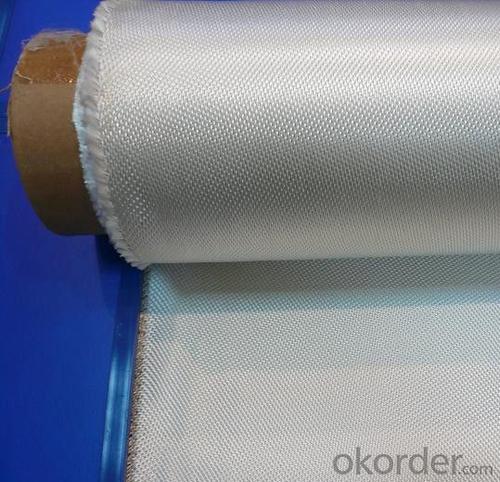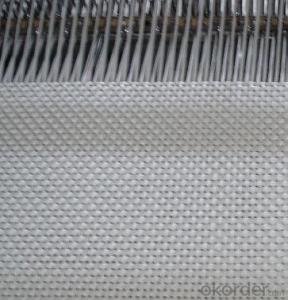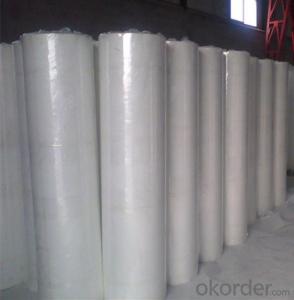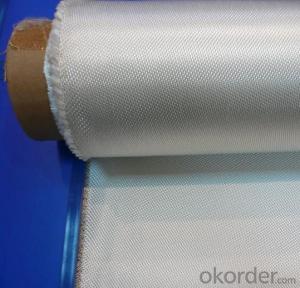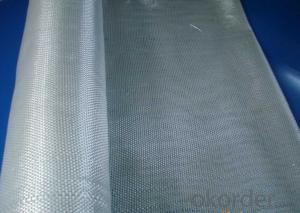Fiberglass Yarn Reinforced Fiberglass Fabric for Sound Absorption ISO:9001
- Loading Port:
- Shanghai
- Payment Terms:
- TT OR LC
- Min Order Qty:
- 500 m²
- Supply Capability:
- 50000 m²/month
OKorder Service Pledge
OKorder Financial Service
You Might Also Like
Fiberglass Fabric for Sound Absorption ISO:9001
Fiberglass Fabric Introduction:
Fiberglass fabric is weaved by high quality fiberglass,as a kind of engineering material,which is
many excellent characteristics:
flame-resisting,corrosion resistant,high strength,heat resistance.stable structure,good chemical resistance,durability.
Fiberglass Fabric Features:
Warp and weft yarns are parallel arrangement as flat situation, with uniform tension;
Fiber is aligned with large consistency, stable and easy operation;
Good moldability, fast and complete wet out in resins, resulting in high productivity;
Good transparency and high strength of composite products.
Fiberglass Fabric Specification:
mark | Fiber consistency(ends/ cm) |
Area weight (g/ m2) |
Thick-ness (mm) |
Width (cm) |
Length (mm) | Breaking strength(N)≥ |
weave | |||
Warp direction | Weft direction | Warp direction | Weft direction | |||||||
EW200 | 16 | 12 | 200±20 | 0.2 | 90-130 | 300-1200 | 980 | 980 | ||
EW210 | 16 | 12 | 200±20 | 0.21 | 90-130 | 300-1200 | 1080 | 1080 | Twill weave | |
Plain weave | ||||||||||
EWR360 | 3.2 | 1.8 | 354±18 | 0.35 | 50-300 | 100 | 2000 | 2000 | ||
EW280 | 16 | 10 | 280±28 | 0.26 | 90-130 | 300-1200 | 1800 | 1800 | ||
EW300 | 14 | 10 | 320±32 | 0.3 | 90-130 | 300-1200 | 1500 | 1500 | ||
EW430 | 20 | 12 | 420±42 | 0.43 | 90-130 | 300-1200 | 2000 | 2000 | Broken twill | |
EWR136 | 10 | 10 | 136±13 | 0.136 | 100 | 200 | 850 | 850 |
Plain weave | |
EWR200 | 8 | 7 | 200±20 | 0.21 | 100 | 200 | 1200 | 1200 | ||
EWR400 | 3.6 | 3.2 | 400±30 | 0.4 | 100 | 50-100 | 2500 | 2500 | ||
EWR600 | 2.6 | 2.5 | 600±50 | 0.6 | 100 | 40KG | 4000 | 4000 | ||
EWR580 | 2.5 | 2.3 | 576±29 | 0.58 | 100 | 40KG | 3850 | 3850 | ||
EWR800 | 1.8 | 1.8 | 800±60 | 0.8 | 100 | 40KG | 4600 | 4600 | ||
Product Show


Fiberglass Fabric Usage:
E-glass woven roving is a schistose double faces reinforcement fabric that is weaved into from roving in directly.
E-glass fiber fabric (thin fabrics with thickness from 0.025 to 0.09mm) is suitable for electrical isolation mica product, wax cloth as the reinforcement materials.
E-glass woven roving applys to all kinds of polyester reinforcement system, (such as unsaturated polyester resin, vinylite,epoxy resin and phenolic resin.
E-glass woven roving is a high performance reinforcement material. It is widely used in hand lay-up and machinery processing products, (such as vessel, container, airplane and vehicle component, furniture, athletic facilities and other industry.
FAQ
1.Package of Fiberglass Fabric?
Fiberglass fabric is wound on a paper tube with inner diameters of 50. 8, 76 or 152mm. Each roll is wrapped in a plastic bag, then to be packed in a carton box. The rolls are to be horizontally placed.
Width (cm): 90, 100, 127
Length (m): 100, 200, 300, 400
2.Storage of Fiberglass Fabric?
Store rolls in a cool, dry location
Protect rolls from weather and other damage.
3.If sample available if needed?
We aim to offer our customer best Products&Service,samples are allowed if necessary.
- Q: How does fiberglass yarn affect the thermal insulation of a product?
- Fiberglass yarn significantly enhances the thermal insulation of a product. Due to its unique properties, such as low thermal conductivity and high resistance to heat, fiberglass yarn acts as a highly effective insulating material. When incorporated into a product, such as insulation blankets, it creates a barrier that minimizes heat transfer. This insulation is crucial in preventing thermal energy loss or gain, maintaining a desired temperature, and conserving energy. Additionally, fiberglass yarn is lightweight and flexible, making it easy to install and mold into various shapes and sizes. Overall, the inclusion of fiberglass yarn in a product greatly improves its thermal insulation capabilities, ensuring optimum performance and energy efficiency.
- Q: What are the thermal conductivity properties of fiberglass yarn?
- Fiberglass yarn, commonly used in various industries and applications, possesses excellent thermal conductivity properties. The thermal conductivity of fiberglass yarn refers to its ability to conduct heat. Fiberglass is known for its low thermal conductivity, meaning it is a poor conductor of heat. This property allows fiberglass yarn to effectively insulate against heat transfer, making it an ideal material for applications that require thermal insulation. The low thermal conductivity of fiberglass yarn can be attributed to its composition. Fiberglass is made of fine strands of glass fibers, which are woven together to form yarn. These glass fibers have a low thermal conductivity due to their amorphous structure, meaning they lack a regular, repeating pattern of atoms. This structure prevents the easy transfer of heat through the material. Additionally, the insulation properties of fiberglass yarn can be further enhanced by incorporating other insulating materials or coatings. For example, fiberglass yarn can be coated with a layer of silicone or other insulating materials to improve its resistance to heat transfer. Overall, the thermal conductivity properties of fiberglass yarn make it a versatile and effective material for thermal insulation applications. Its low thermal conductivity helps to minimize heat transfer, making it suitable for use in industries such as construction, automotive, aerospace, and manufacturing, where thermal insulation is crucial.
- Q: Is fiberglass yarn suitable for use in heat insulation?
- Indeed, heat insulation can make good use of fiberglass yarn. Fiberglass, a highly versatile and extensively employed material for insulation purposes, owes its popularity to its exceptional thermal characteristics. With low thermal conductivity, it proves to be an inefficient conductor of heat. This quality enables fiberglass yarn to effectively impede heat transfer, rendering it appropriate for heat insulation. Moreover, fiberglass boasts fire-resistant properties, which further bolster its aptness for heat insulation objectives. In its yarn form, fiberglass permits effortless manipulation and installation, making it a pragmatic option for diverse insulation applications, encompassing buildings, industrial machinery, and automotive parts.
- Q: How does the UV resistance of fiberglass yarn compare to other materials?
- The UV resistance of fiberglass yarn is considered to be excellent when compared to other materials. Fiberglass is known for its ability to withstand prolonged exposure to sunlight and other UV rays without deteriorating or losing its strength. This makes fiberglass yarn a popular choice for outdoor applications where UV resistance is crucial, such as in the manufacturing of outdoor furniture, awnings, and boat covers. In contrast, some other materials, such as cotton or polyester, may not offer the same level of UV resistance and may fade, weaken, or become brittle when exposed to extended periods of sunlight. Therefore, fiberglass yarn is often preferred over other materials when it comes to withstanding UV radiation.
- Q: How does fiberglass yarn compare to other yarn materials?
- Fiberglass yarn is a unique material that offers several advantages when compared to other yarn materials. Firstly, fiberglass yarn is incredibly strong and durable, making it ideal for applications that require high tensile strength. It can withstand heavy loads and does not easily break or stretch like other yarn materials such as cotton or wool. This strength also makes fiberglass yarn resistant to abrasion, ensuring its longevity and performance over time. Secondly, fiberglass yarn is highly heat-resistant. It can withstand extremely high temperatures without melting or losing its structural integrity. This property makes it suitable for use in applications where heat resistance is crucial, such as insulation, fireproofing, and electrical components. Additionally, fiberglass yarn is highly resistant to chemicals and corrosion. It does not react with most chemicals or solvents, making it an excellent choice for applications that involve exposure to harsh chemicals or corrosive environments. This resistance to corrosion ensures that fiberglass yarn remains intact and functional, even in challenging conditions. Furthermore, fiberglass yarn is lightweight and has excellent dimensional stability. It is not prone to shrinking or expanding when exposed to moisture or changes in temperature. This stability makes it an ideal material for precision applications, where accuracy and consistency are essential. However, it is important to note that fiberglass yarn also has some limitations. It is not as soft or flexible as natural yarn materials like cotton or wool, which may limit its use in certain textile applications. Additionally, fiberglass yarn can be more expensive than other yarn materials due to its unique properties and manufacturing process. In conclusion, fiberglass yarn offers several advantages when compared to other yarn materials. Its strength, heat resistance, chemical resistance, corrosion resistance, and dimensional stability make it a versatile material that can be used in various industries and applications. However, it is essential to consider the specific requirements of each project and the limitations of fiberglass yarn before choosing it as a yarn material.
- Q: Can fiberglass yarn be used for making artificial flowers?
- Yes, fiberglass yarn can be used for making artificial flowers. Fiberglass yarn is lightweight, flexible, and durable, making it an ideal material for crafting artificial flowers. It can be easily molded into various shapes and sizes, allowing for the creation of intricate and realistic flower petals. Additionally, fiberglass yarn is resistant to fading and damage from sunlight, making it suitable for long-lasting artificial flowers that can be displayed indoors or outdoors.
- Q: Can fiberglass yarn be used for high-performance applications?
- Yes, fiberglass yarn can be used for high-performance applications. Its high strength, durability, and resistance to heat and chemicals make it suitable for various industries such as aerospace, automotive, and construction. Additionally, its lightweight nature allows for increased efficiency and performance in these applications.
- Q: Can fiberglass yarn be used for making gloves?
- Gloves can indeed be made using fiberglass yarn. This type of yarn is well-known for its exceptional durability and heat resistance, which makes it suitable for various applications requiring protection and longevity. One such application is gloves, where fiberglass yarn can offer a remarkable level of thermal resistance and safeguard against cuts, abrasions, and other potential dangers. Moreover, fiberglass yarn can be combined with other materials to enhance its properties, such as by introducing flexibility or comfort. However, it is vital to bear in mind that fiberglass has the potential to irritate the skin and trigger allergic reactions in certain individuals. Hence, it is crucial to adopt appropriate safety precautions, including the use of protective clothing and gloves, when handling fiberglass yarn or products.
- Q: How does the strength of fiberglass yarn compare to other materials?
- The strength of fiberglass yarn is generally considered to be stronger than many other materials, such as cotton or wool yarn. It has a high tensile strength, meaning it is resistant to breaking or stretching under tension. This makes fiberglass yarn a popular choice for applications that require durability and strength, such as in the construction industry or for reinforcing composites.
- Q: How does fiberglass yarn affect the flexibility of a product?
- The flexibility of a product can be altered depending on the utilization of fiberglass yarn. Fiberglass itself is a sturdy and inflexible material, but when transformed into yarn, it becomes more adaptable and pliable. When incorporated into the manufacturing process, fiberglass yarn can offer reinforcement and structural strength, while allowing for a certain amount of flexibility. The quantity and compactness of fiberglass yarn employed can significantly impact the flexibility of a product. Increasing the amount of fiberglass yarn can enhance rigidity and decrease overall flexibility. Conversely, using a lower density of fiberglass yarn or combining it with other materials can help maintain or even improve the product's flexibility. Furthermore, the manner in which fiberglass yarn is woven or knitted together can also influence product flexibility. Different weaving or knitting techniques can produce varying degrees of flexibility, enabling the creation of customized products with specific flexibility requirements. In conclusion, fiberglass yarn can affect the flexibility of a product by providing reinforcement and structural strength. The amount, density, and weaving or knitting technique utilized all play a role in determining the level of flexibility achieved. By carefully considering these factors, manufacturers can ensure that the final product meets the desired level of flexibility while still benefiting from the strength and durability that fiberglass yarn offers.
Send your message to us
Fiberglass Yarn Reinforced Fiberglass Fabric for Sound Absorption ISO:9001
- Loading Port:
- Shanghai
- Payment Terms:
- TT OR LC
- Min Order Qty:
- 500 m²
- Supply Capability:
- 50000 m²/month
OKorder Service Pledge
OKorder Financial Service
Similar products
Hot products
Hot Searches
Related keywords


